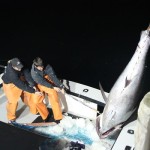You can’t read a newspaper these days without learning about new repercussions from the global economic downturn. USA Today reported yesterday that college students are struggling because cost of food and rent is high. One of the consequences is that students are cutting back on meals. Zack Hall, a student at University of Texas says “We eat so much tuna, it’s not even funny.”
Uh-oh. Danger, Will Robinson. Over consumption of canned tuna can lead to “fish fog“. Consider this scenario- economy goes down, tuna consumption goes up, mercury levels rise, memory loss ensues, and grades drop. It’s a downward spiral. Kind of like tuna flying off the shelves in the face of a hurricane. Canned tuna may not be the healthiest choice, especially if you’re pregnant.
Dig a little deeper into the global economics of tuna consumption and you’ll find yourself reading a China News story about the city of General Santos, the Tuna Capitol of the Philippines.
Daily in this coastal city, around 280 tons of giant yellow-fin tunas are prepared and processed for distribution all over the world. In less than 24 hours after being unloaded by fishermen from their vessels docked in this city’s world-class fish port, the fresh tuna will turn into pink sushi in finest foreign bistros thousands of kilometers away.
However, tuna landings are down 22% from last year, and scientists from Manila’s Fisheries Research Development Institute already claim that global warming is to blame. Tuna fish are moving into cooler waters, they say, and fishermen are traveling further offshore to catch fish. Fishermen are spending about 3,850 to 9,600 U.S. dollars per trip in oil expenses.
Meanwhile, the ongoing financial crisis is resulting in weaker demand from traditional tuna markets in the Unites States and European countries. The solution for Philippines fisheries, it seems, is captive rearing of tuna, and increased trade with China. With a population of 1.3 billion, China is likely to become a great market for the Philippines’ tuna industry, says Marfin Tan, a tuna company owner. And you expected good news?
So the question of whether tuna consumption is going up or going down may depend on the country, type and quality of tuna that we’re talking about. Either way, climate change, oil prices, and consumer spending choices seem to be tightly bound around the future of tuna.






With yellow fin the lifecycle has been completed in captivity and there has been a pretty successful pilot captive breeding to market aquaculture program (as soon as my laptop comes back from Apple I can provide reference). While I have some misgivings about it it is feasible at this point with yellowfin (and with bluefin for that matter) to have a complete captive aquaculture operation. The issue of feeding them is still there though. The intensive aquaculture impacts and possible issues with fish disease could easily devastate the local area ecosystems too.
Yes, its true. I’ve seen some presentations on the impacts of tuna aquaculture to seagrass ecosystems in the Mediterranean. Seagrass directly below the feeding pens were pretty degraded, as I recall.
I’ve been watching the tuna and swordfish markets for years, and I still don’t understand all of the reasons for its fluctuations! Part of it is that tuna (much more than swordfish) is a global commodity, such that a bluefin pulled from a pen in Spain and a bigeye landed in Rhode Island have an equally good chance of being on the auction floor at Tsukiji the next morning. The book “The Sushi Economy: Globalization and the Making of a Modern Delicacy” by Sasha Issenberg is a pretty good, if not necessarily deep, overview of this, well, “globalization” of tuna product.
I guess that the one thing I’d add here is that there are huge differences between tunas in this global market, which I’d roughly separate into three categories. The first is the low-value (per pound price, not volume) tunas such as skipjack, which support many artisanal fisheries with local or regional markets. The second would be the moderate value ones like albacore and yellowfin, some of which is exported fresh, but mostly leaves the country of landing as canned or otherwise processed (e.g., IQF tuna steaks) product. The vast majority of the albacore and yellowfin landed in the U.S. Atlantic fishery is retained domestically. Finally, the third category would be the high-value bluefin and, to a slighly lesser but growing extent, bigeye tunas. While the global increase in domestic sushi and sashimi markets has reduced the number of tunas flown into Japan, these are the two species which constitute most of the U.S. fresh tuna exports.
I guess my point is that college students are likely eating canned albacore, not bigeye, and that these different and somewhat substitutable (see http://ageconsearch.umn.edu/bitstream/28175/1/12030143.pdf) tuna species all affect the markets differently. Regardless, for the commercial fisheries of all types that depend on these varying market conditions to make payrolls and vessel costs, the next year or so is going to be a bumpy ride.
Desptive having only a few dozen miles of sea line, Slovenia did manage to muster up a few aquaculture pans in a few bays. It turned out that local pollution from feeding is really terrible, judging from benthos perspective. On the bright side, it’s only local and is minute compared to effluents from sewers.
And regarding tuna, I really liked it, but I found out that it gave me mouth lesions so I gave it up. Can’t say I miss it, especially in lieu of the mercury levels. I must say I’ve kicked back on sea food, especially after realizing how much Hg enters the Gulf of Trieste. It’s one of those stories that come handy if one wants to scare people browsing for fish cans in the local super market.